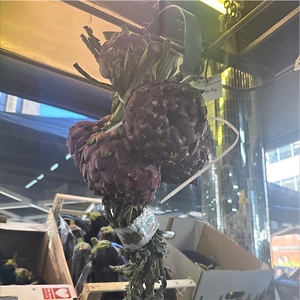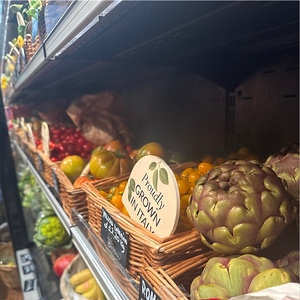


Mammole Artichokes
Estimated Inventory, lb : 0
Description/Taste
Mammole artichokes are compact, averaging 10 to 12 centimeters in diameter, and are typically smaller than the large commercial globe violet varieties commonly sold in markets. The artichokes have a round, spherical shape and are comprised of densely layered bracts, colloquially referred to as leaves. A distinguishing characteristic of Mammole artichokes is their spineless nature and small hole at the top of the head. The outer purple-green bracts are fibrous, striated, smooth, and tough, but even the toughest bracts on this artichoke are still softer than other types of commercial artichokes. As each exterior bract is stripped away, the interior bracts lighten in color to shades of light purple, pale green, and tinges of yellow. Interior bracts are fleshier and can be eaten raw when young and tender. Some Mammole artichokes will have a small, underdeveloped choke, while others may not have a choke at all, depending on the time the artichoke was harvested. Chefs highly value this trait as it reduces waste and shortens preparation time. Mammole artichokes can be eaten raw when stripped of the outer bracts and picked young, but the artichokes are more popularly cooked to develop a succulent, soft texture. Cooked Mammole artichokes have a mild, sweet, subtly bitter, pleasantly grassy, and green flavor.
Seasons/Availability
Mammole artichokes are harvested from mid-winter through late spring, with a peak season in March and April.
Current Facts
Mammole artichoke, botanically classified as Cynara scolymus, is a descriptor for Italian artichoke varieties traditionally sold in the Lazio region, belonging to the Asteraceae family. Artichokes are a representative springtime culinary ingredient in the city of Rome. The Lazio region is famous for Mammole artichokes, also known as Cimaroli artichokes, Romaneschi, Mammola, Carciofo Romanesco, and Roman artichokes. The name Mammole translates from Italian to mean “violet.” There are two main varieties generally sold under the Mammole name, the first being Casellammare, a cultivar that typically arrives early in the markets, followed by Campagnano. It is important to note that Mammole artichokes grown in specific provinces of Lazio have also been awarded an Indication of Geographical Protection, or IGP, earning some artichokes in markets the title of Carciofo Romanesco del Lazio IGP. Mammole artichokes are a seasonal delicacy valued by chefs and consumers for the artichoke's mild, sweet taste, fleshy bracts, and low waste. The artichokes are typically harvested when they are young and have not developed a choke and are cut from the plant with their stems still mostly intact as a sign of freshness. Once the artichokes are sold in markets, vendors trim the ends of the stems for the consumers. Mammole artichokes are utilized raw and cooked in a wide array of culinary preparations, and almost the entire head can be prepared and eaten. In Italy, Mammole artichokes are an anticipated crop, and the artichokes are cooked at home, served in restaurants, and showcased in regional festivals.
Nutritional Value
Mammole artichokes have not been extensively studied for their nutritional properties. Like other violet-hued artichokes, they may be a source of fiber to regulate the digestive tract, calcium to build strong bones and teeth, phosphorus to repair tissues, and vitamin C to strengthen the immune system. Artichokes also provide vitamin K to assist the body in faster wound healing, magnesium to control optimal nerve functioning, folate to produce genetic material such as DNA and RNA, potassium to balance fluid levels within the body, iron to develop the protein hemoglobin for oxygen transport through the bloodstream, and other nutrients, including copper, manganese, and zinc. One of the more notable aspects of purple artichokes is their pigmented coloring, created by anthocyanins in the skin. Anthocyanins contain antioxidant-like properties to protect the cells in the body against the damage caused by oxidative stress and free radicals.
Applications
Mammole artichokes have a mild, sweet, and subtly grassy taste suited for fresh and cooked preparations. The variety can be eaten fresh out of hand if it is picked very young and only the interior bracts are consumed. When served raw, the artichokes can be cut into thin slices and served with mint, olive oil, salt, lemon juice, and a sprinkling of cheese such as Parmigiano Reggiano. Mammole artichokes can also be steamed, boiled, used as a pizza topping, cooked and tossed into pasta, or mixed into risotto. In Rome, Mammole artichokes are famously used in Carciofi alla Romana and Carciofi alla Giudia. Carciofi alla Romana translates from Italian to mean “Roman-style artichokes” and is a dish of artichokes simmered in fresh herbs, oil, and water or wine. The exterior bracts are removed from the artichoke, leaving a portion of the stem and the artichoke’s heart intact, and this part is simmered to develop a tender, succulent, and decadent appetizer or side dish. Carciofi alla Giudia, or “Roman-Jewish Fried artichokes,” is a dish once served as an appetizer for Jewish holidays such as Yom Kippur. Artichokes are stripped to their inner, fleshy bracts and are double-fried to create a crisp, crunchy dish. The fried artichokes expand when they cook to resemble a flower, and the fried bracts have a consistency similar to a crunchy potato chip. Beyond Rome’s two most customary artichoke dishes, Mammole artichokes can be used in any recipe calling for common artichokes. They are typically stuffed with breadcrumbs and herbs or cooked in simple methods to serve as a side dish to seafood and roasted meat. Mammole artichokes pair well with herbs such as parsley, mint, basil, and oregano, cheeses including parmesan, pecorino, goat, and feta, nuts such as pine, pistachio, and almond, citrus, and meats including duck, lamb, pork, or beef. Whole, unwashed Mammole artichokes have a short shelf life and will only keep in the refrigerator for a few days. It is recommended to immediately consume the variety after harvest for the best quality and flavor.
Ethnic/Cultural Info
Mammole artichokes are more commonly known as Carciofo Romanesco in Italy and are annually celebrated at the Sagra del Carciofo Romanesco di Ladispoli, one of the most famous food festivals in the Lazio region. The festival was established in 1951 to honor the signature artichoke of the region, and in 2024, it will mark the 71st celebration. Since its creation, the week-long festival is customarily held each year at the beginning of April. Ladispoli is a coastal commune in Rome and was named after Italian Prince Ladislao Odescalchi in 1888. The commune is known for its artichoke cultivation, and Carciofo Romanesco is one of the most widely produced artichokes in the region. During the festival, Ladispoli is filled with international and Italian visitors sampling artichoke-centric dishes from local vendors. Carciofo Romanesco is prepared using traditional methods, and the dishes are eaten in the street with family and friends while live musical performances create a lively atmosphere. Restaurants also offer fixed-price menus centered around artichokes for enhanced experiences. Beyond consuming artichokes, the Sagra del Carciofo Romanesco is famous for artichoke sculptures. Each year, a contest is held to determine the best handmade sculpture, and entries have ranged from elephants, turtles, horses, boats, castles, and butterflies, all made from artichokes.
Geography/History
Mammole artichokes are native to Italy and are descendants of varieties cultivated in the region for centuries. It is unknown when artichokes were first introduced to the modern-day Italian peninsula, but wall inscriptions in an ancient Etruscan necropolis in Tarquinia, a city in the Lazio region, allude to ancient artichoke varieties being present during the Etruscan Civilization from the 8th century to the 3rd century BCE. Artichokes were notably cultivated during the 15th century and were spread from Naples to Tuscany. It is unknown when Mammole artichokes were developed from other older varieties, but the artichokes became established in the coastal regions near Rome. Historically, Mammole artichokes were referred to as Mammola or Cimarolo, but over time, they became known as Carciofo Romanesco or the Roman artichoke. Mammole artichokes are also thought to be a general name for Campagnano and Castellammare artichokes grown in specific regions of Lazio. In 2002, artichokes produced in specific provinces of the Lazio region obtained an Indication of Geographic Protection, also known as an IGP, to acknowledge and promote the region’s distinct crop. Today, Mammole artichokes are cultivated in several municipalities in the Viterbo, Rome, and Latina provinces within the Lazio region. They are primarily grown along the coast in the communes of Ladispoli and Cerveteri. When in season, Mammole artichokes are locally sold throughout Lazio and are also exported to other regions of Italy and European countries. The Mammole artichokes featured in the photograph above were sourced through Natoora in London.
Recipe Ideas
Recipes that include Mammole Artichokes. One
| Mad & Delicacy |
|
Roman Style Mammole Artichokes Recipe |










